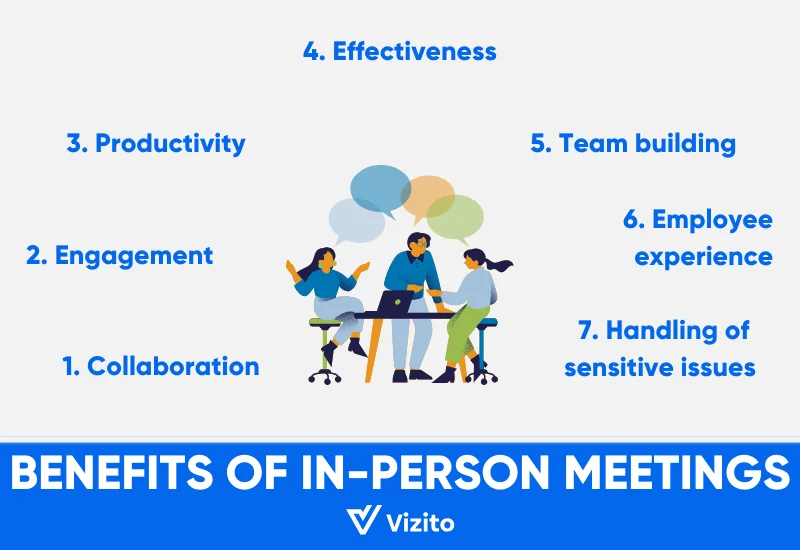
Jun 03, 2025
Join us in this blog post as we explore the significance of in-person meetings in the age of digital communication. We’ll delve into the advantages of face-to-face interactions, and share our best tips for hosting effective face-to-face meetings.
Written by Jill - Written: October 14, 2023

In the past few years, digital meeting platforms have soared in popularity. Especially during the COVID pandemic, they became essential tools for businesses worldwide, offering continuity, flexibility, and convenience.
In our technological age, with the allure of digital conveniences like Zoom, Teams, and the likes, one might wonder: do in-person meetings still hold any relevance?
The answer is: yes. Interestingly, many organizations are rediscovering the inherent benefits of personal interactions. Face-to-face meetings are making a comeback, and here’s why:
So, while online meetings can still be useful for quick check-ins, businesses shouldn’t entirely abandon traditional face-to-face interactions. In this blog post, we will delve deeper into these advantages. As a bonus, we will share our tips for hosting effective in-person meetings.
In-person meetings require participants to come together in the same location to discuss work, collaborate, or make decisions. Typical aspects of these meetings are:
While in-person meetings may be more time-consuming than digital gatherings and come with some challenges such as travel costs and the need for physical spaces, the benefits often outweigh the drawbacks.
So, why is meeting in person better than via Zoom or other online platforms? Pose this question to many professionals, and a significant number will praise the convenience of virtual meetings. You can join from anywhere, without facing traffic or lengthy commutes. But when it comes to communicating effectively and collaborating with colleagues, nothing beats a good old face-to-face meeting.
One primary benefit of meeting in-person is the dynamics of face-to-face communication. Digital meetings, while convenient, may make it harder to fully grasp what a colleague is conveying. In a physical setting, participants can immediately ask questions and react to someone elses feedback.
Another critical factor is that team members don’t only hear each other’s words, but also see non-verbal cues like facial expressions, gestures, and body language. A nod of agreement, a skeptical frown, or an enthusiastic hand gesture can say more than words, helping colleagues better understand each other’s perspectives, and ensuring fewer misunderstandings.
These dynamics are particularly important during brainstorming sessions. The spontaneous nature of face-to-face interactions means that ideas can be thrown, built upon, and refined in real-time. The immediacy of feedback, coupled with the ability to gauge reactions instantly, helps in refining and developing ideas organically.
For a broader look at the benefits the physical workplace offers, read our article on the advantages of working in the office. You can also check out our tips for hybrid working.

Engagement is a crucial factor in any productive discussion, and face-to-face meetings often outshine their digital counterparts in this regard. When participants gather in a shared physical space, they naturally become more attuned to the conversation and the individuals around them.
One standout advantage of in-person meetings is the minimization of distractions. In a digital setting, it’s all too easy for participants to become sidetracked — be it by checking emails or social media, or attending to a roommate or pet vying for attention. In contrast, a face-to-face environment inherently commands attention. The very act of sitting around a conference table or being in the direct line of sight of a speaker fosters a sense of responsibility to remain focused.
The tangible presence of colleagues also means that coworkers are more likely to be actively involved in the discussion. It encourages individuals to share their thoughts, ask questions, and respond to ideas raised by others.
As the digital workforce expands, an increasing number of employees prefers telecommuting over working in the office, and digital communication over any other form. However, despite a rapid evolution in business collaboration tools, nothing has proven to be more effective than face-to-face interactions.
According to a survey by Great Business Schools, face-to-face conversations are generally more positive and are perceived as more credible compared to online discussions. An explanation lies in the fact that the actual words we say make up only a small fraction (7%) of human communication. Meanwhile, the tone of voice accounts for 38%, and facial expressions for a whopping 55%.
Furthermore, when comparing idea generation, face-to-face interactions produce more ideas (13.36 per session) than virtual ones (10.43 per session). The quality of these ideas is also perceived to be superior during in-person meetings.
Of course interactions are not just about numbers, but the depth of relationships they foster. 85% of respondents believe that in-person meetings forge stronger and more meaningful business connections. Almost half (49%) also feel these meetings enable more intricate strategic thinking.
When orchestrating these invaluable face-to-face meetings, it’s crucial to streamline and secure your visitor experience. If you want to experience the benefits of a modern visitor management system, take advantage of Vizito’s 14-day trial today.
In-person meetings inherently lend themselves to more effective problem-solving approaches. Hands-on, visual tools such as whiteboards and flip charts are often more effective than their virtual counterparts.
The physical presence amplifies the creative energy, facilitating clearer understanding and more immediate feedback, ultimately leading to more actionable and innovative solutions.
Sharing a laugh over a spontaneous moment, casual conversations before and after a meeting, or even the shared experience of a meal or coffee break — these seemingly minor moments contribute significantly to team bonding.
The simple act of gathering in a shared space can foster a sense of camaraderie and mutual understanding that virtual interactions often struggle to replicate. Being physically present with team members allows for an organic exchange of personal stories, experiences, and interests, which in turn can strengthen interpersonal relationships and trust.
If you’re connecting with a new client or someone you’re still building a relationship with, think about setting up a face-to-face meeting over coffee or at your office to solidify the bond.
When employees meet in person, it fosters a sense of belonging and community. They can connect on a more personal level, share experiences, and build relationships that go beyond just professional interactions. The bond established in in-person settings often translates to improved morale, loyalty, and job satisfaction.
Additionally, face-to-face meetings give employees the opportunity to get direct feedback, ask questions, and clarify doubts. This immediate two-way communication ensures that employees feel heard and valued, promoting a transparent and inclusive work environment.
In essence, while digital tools offer convenience and flexibility, in-person interactions complement these advantages by adding a human touch to the employee experience, making it more fulfilling.
For more information and tips on improving employee satisfaction, read our article on the impact of a positive workplace environment on morale and happiness.
Addressing sensitive topics requires a nuanced approach, and in many instances, face-to-face meetings are the best medium for such discussions. In a physical setting, it’s easier to convey empathy, understanding, and genuine concern — qualities that can be challenging to communicate digitally. When participants can see each other’s facial expressions and body language, there’s a better chance for compassion and comprehension, reducing the risk of misunderstandings or misinterpretations.
Moreover, the privacy of an in-person discussion ensures confidentiality and offers an environment where individuals can feel more secure and open in expressing their concerns or feelings. In situations where trust and discretion are paramount, face-to-face meetings remain the standard.

Ensuring in-person meetings are efficient and productive is crucial for making the most out of everyone’s time. Here are some tips to help achieve that:
By incorporating these tips, in-person meetings can become more streamlined, purposeful, and results-driven, ensuring they add value to all participants and the overall organization.
In our digitally-driven age, it’s tempting to solely rely on virtual platforms for business communication. However, as we’ve explored, the irreplaceable value of in-person meetings cannot be overstated. Face-to-face interactions offer a depth of understanding, collaboration, and relationship-building that digital means often fall short of capturing. While tools like Zoom and Teams have their merits, they should complement rather than replace in-person dialogues.
Integrating modern tools, such as a visitor management system (VMS), can significantly enhance the experience of in-person interactions. VMS solutions like Vizito streamline the arrival and management of guests, melding traditional face-to-face benefits with cutting-edge technology to optimize the meeting experience.
For businesses seeking to thrive in today’s complex landscape, finding the right equilibrium between digital and in-person interactions is paramount. Embrace the convenience of digital tools, but never underestimate the profound impact of a handshake, a shared laugh, or a face-to-face conversation.
To get a feel of how a modern visitor management system can help your business, try out Vizito during a 14-day trial. Chat with us or book a demo to discuss how Vizito can help you improve your reception.